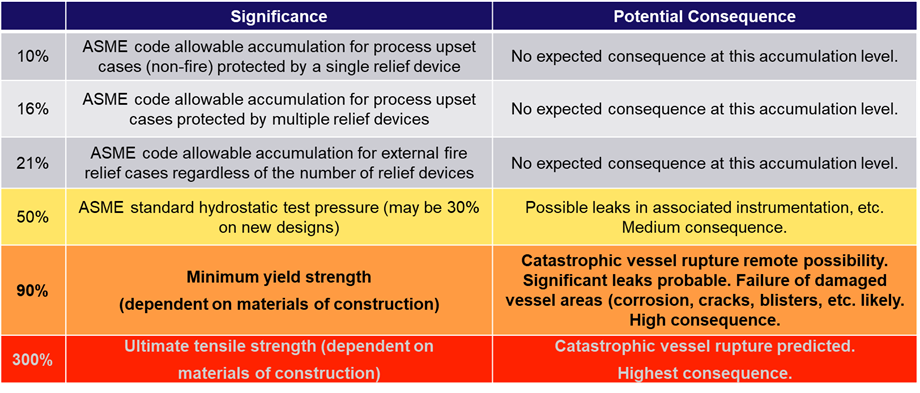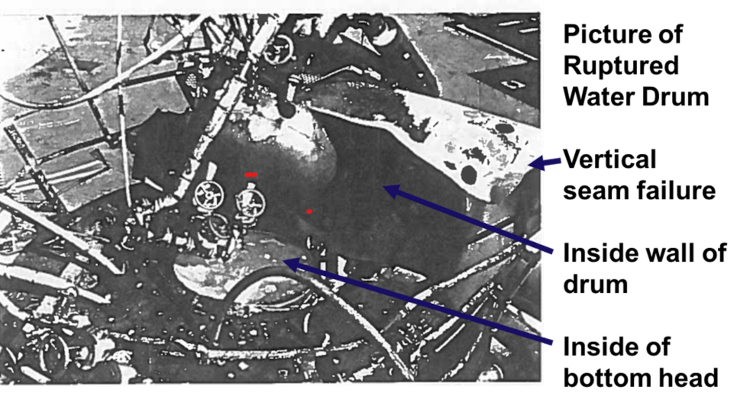Hydroprocessing Relief Issues – Chapter 1: Backflow Prevention
Over the next few months I will cover relief issues for Hydrotreaters and Hydrocrackers. This topic will be the subject of an AFPM Safety Bulletin to be released in 2Q, 2023.
Relief design and operation for hydroprocessing units has unique requirements compared to other refinery units because of the high-pressure-to-low-pressure interfaces. The trick is to keep the high pressure from migrating to the low-pressure sections of the unit and to other units that operate at low pressure. This month’s discussion will cover backflow prevention – preventing high-pressure fluids from flowing to low-pressure systems on the feed, wash water, and amine systems. Future articles will discuss separator vapor blow-through and issues with two-phase flow in relief systems.
Overpressure
The reason that Hydro processing Units are cause for special concern is the ratio of pressure between the high-pressure system and the adjacent low-pressure system is often high enough to cause rupture of the low-pressure system. The table below shows various levels of overpressure that cause concern:
Overpressure Consequences

![]()

The table above shows that catastrophic vessel rupture is likely at 300% overpressure. Hydroprocessing units often have a high-pressure loop operating at pressures exceeding 2500 psig or more with feed or wash systems with design pressures less than 300 psig resulting in a potential overpressure of 1000%
My Personal Backflow Incident
On the morning of Christmas Eve, 1992, I had just got out of bed when I heard a news bulletin about a fire at my refinery. A few seconds later, the phone rang with an invitation to join others at the refinery to discuss the fire and how to fix the damage.
The reciprocating feed pump on a small hydrotreater had failed, allowing one of the plungers to be ejected from the pump. The entire volume of high-pressure recycle gas and oil flowed backwards through a check valve and out of the open feed pump cylinder. The gas/oil mixture ignited, creating a very spectacular fire. The instrumentation and control cables were damaged almost immediately, cutting off all ability to shut down the unit from the control room. Operators closed all the valves at the plot limit and had to watch the unit depressure and burn until the fuel was exhausted, and the fires extinguished.
Fortunately, there were no injuries from this incident. The hydrotreater operated at 1800 psig, so the amount of energy released was substantial and we were very lucky to avoid injuries and fatalities.
One vivid memory I have of the event was a spirited discussion as to why the check valve didn’t stop the backflow. There were lots of opinions, but I remember a seasoned operator stating that he NEVER expects check valves to hold.
It took us about 6 months to get the damaged equipment replaced and the unit back on-line. I was proud of the fact that we scrambled and had ordered most of the replacement equipment by the end of that Christmas Eve Day. The picture below shows some of the damage from the fire:
Two More Backflow Incidents
1. NHT Backflow
A few years after the incident described above, a naphtha hydrotreater experienced a backflow incident on the feed system. After the feed pump stopped, the high-pressure fluids flowed backwards through a check valve, through the feed pump, and into the feed system and blew an elbow off the feed piping in a nearby pipe trench. Unfortunately, an operator was working in the trench nearby and was badly burned in the subsequent fire.
2. Wash Water Backflow
We found out that a third backflow incident had occurred in another refinery some years before the first incident described above. The wash water pump on a high-pressure (2500 psig) hydrotreater stopped, allowing high-pressure fluids to pass backwards through 2 check valves and the pump minimum flow bypass line to the water surge drum. The surge drum had a 1” vent pipe open to relief, but it was inadequately sized for backflow and the drum ruptured due to the high pressure. A rough flow diagram of the wash water system is shown below.

Two operators were working on the wash water pump nearby, but the surge drum was elevated and far enough away to prevent causing injury. The drum rupture was heard several miles away in neighboring communities. A picture of the ruptured drum is shown below. Although the picture is difficult to interpret, it clearly shows the drum rupture was a complete vessel failure.

Why Service Critical Check Valves?
Although check valves are not sufficient to prevent backflow by themselves, they are still helpful as a good engineering practice if they function correctly. Check valves associated with backflow protection should be designated as “critical” check valves requiring maintenance at each major turnaround.
The pictures below show how heavy feeds or contaminants can foul the check valves in backflow protection service. This check valve is in sour water service and the sour water was contaminated with oil that fouled the check valve. This is the reason critical check valves should be serviced at every major turnaround.

Lessons from Backflow Incidents
- Check valves alone are inadequate to prevent backflow in hydroprocessing units
- Application of Layer of Protection Analysis (LOPA) has confirmed that check valves are not enough to prevent backflow in hydroprocessing units where the potential overpressure exceeds 300%
-
- Check valves are still a “good engineering practice” when installed with an upstream relief valve according to API 521 but are inadequate to protect against backflow in hydroprocessing units without additional layers of protection.
- Check valves in backflow service should be designated as “critical” check valves that require maintenance at every major turnaround.
- One very wise Operations Superintendent quipped, “Check valves are only good for door stops and boat anchors!”
- Additional layers of protection commonly used
- Some units have provided additional layers of protection by installing a chopper valve on the feed, wash water, and amine systems that closes quickly on low flow.
- The chopper valve must close before the high-pressure fluids can reach the low-pressure system – this is often within seconds.
- Some units have used a relief valve on the surge drum to provide additional layers of protection.
- The relief valve must be sized for full backflow
- The relief drum must be able to fully contain the liquid surge volume to prevent two-phase flow into the relief system.
- Some units have provided additional layers of protection by installing a chopper valve on the feed, wash water, and amine systems that closes quickly on low flow.
- Reciprocating pumps are not sufficient for backflow protection
- I have heard many people claim that they are immune from backflow because the feed, wash water, or amine pump is a reciprocating pump, but 2 out of the 3 backflow incidents described in this article involved reciprocating feed pumps
- One pump experienced a failed cylinder
- Another incident experienced backflow through the minimum flow bypass
- Most reciprocating pumps leak constantly and require frequently repairs – do not believe for a minute that backflow isn’t possible with a reciprocating pump!
- I have heard many people claim that they are immune from backflow because the feed, wash water, or amine pump is a reciprocating pump, but 2 out of the 3 backflow incidents described in this article involved reciprocating feed pumps
Application in your unit(s)
It’s possible that you have not experience a backflow incident in your career or perhaps even in your unit, but one of the purposes of this article is to show what can happen and that possible outcomes include personnel injury and devastating plant destruction.
Does your unit or units have adequate backflow protection on the feed, wash water, and amine systems?
Next month, we’ll discuss blow-through issues.




